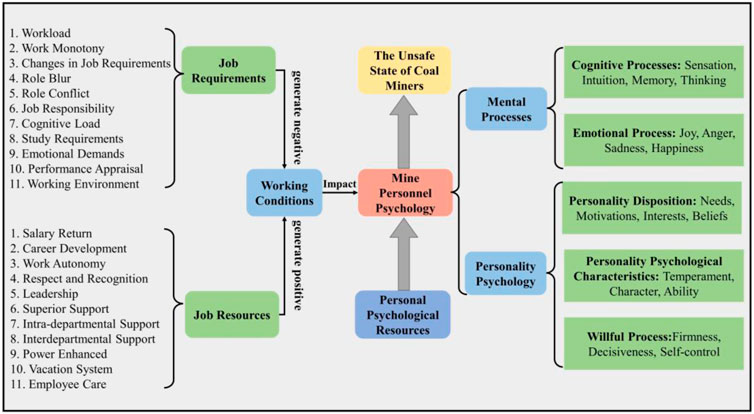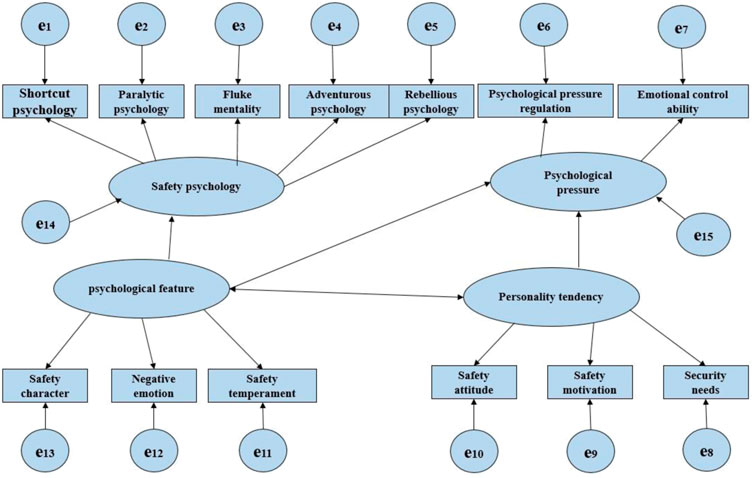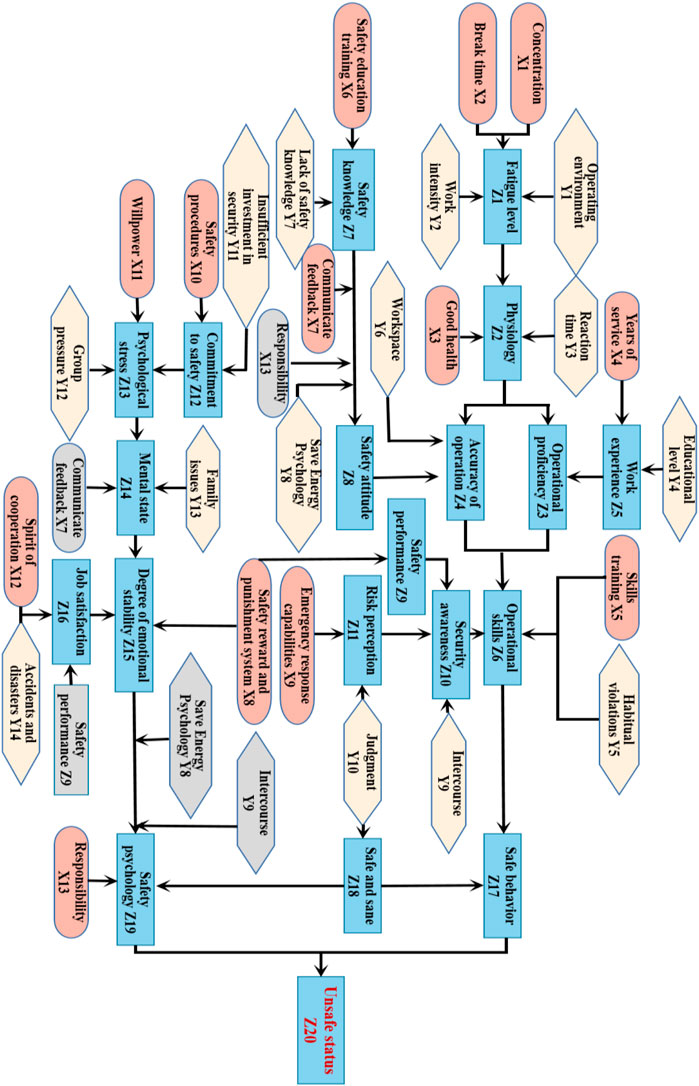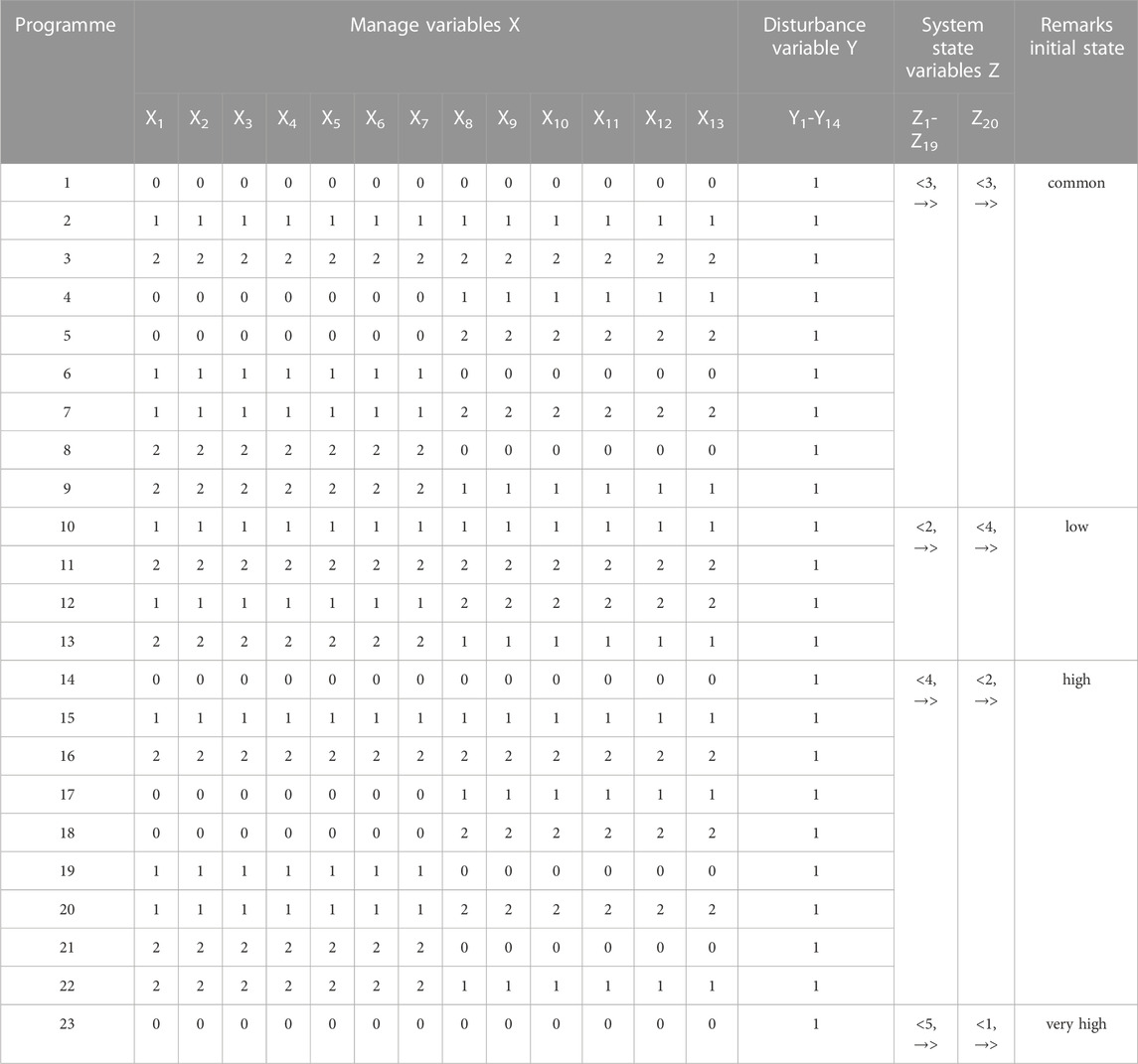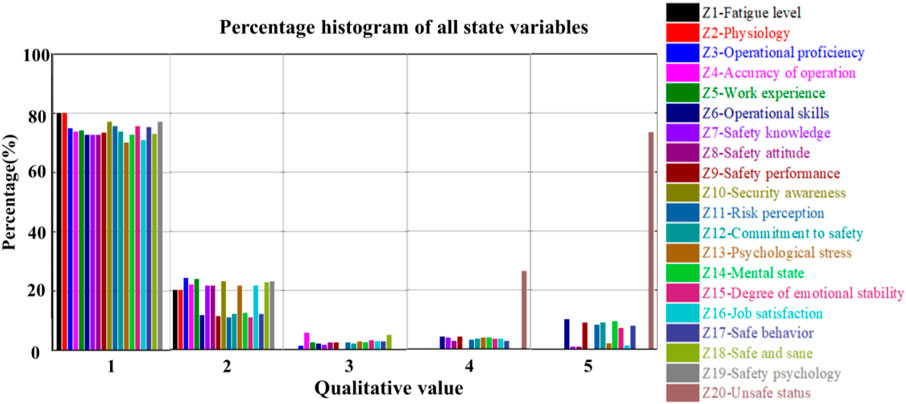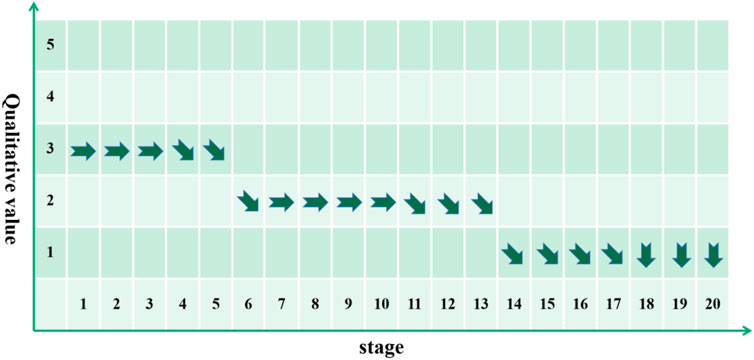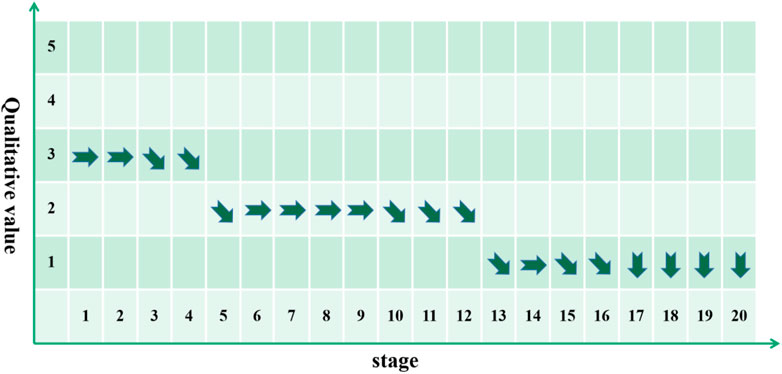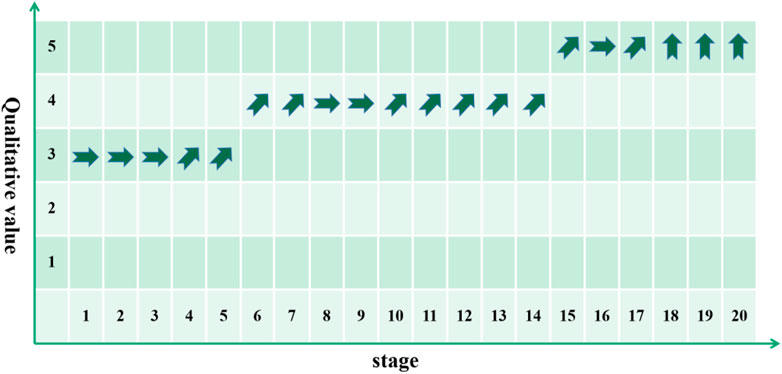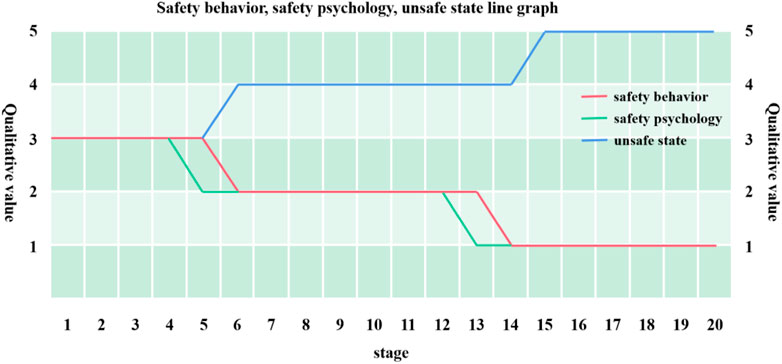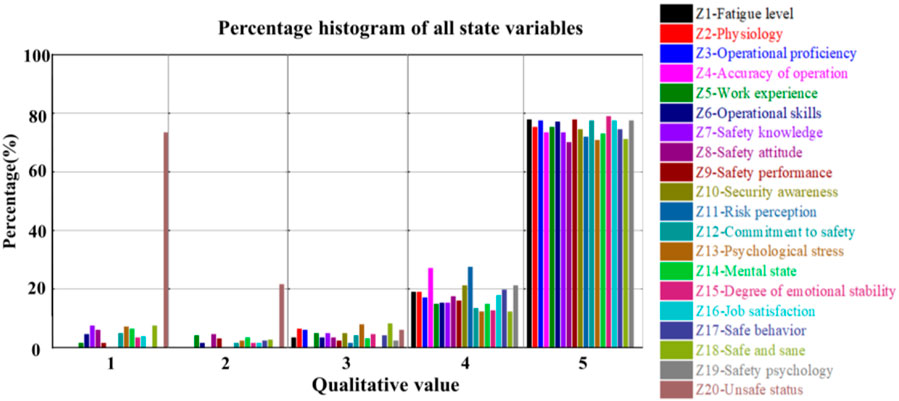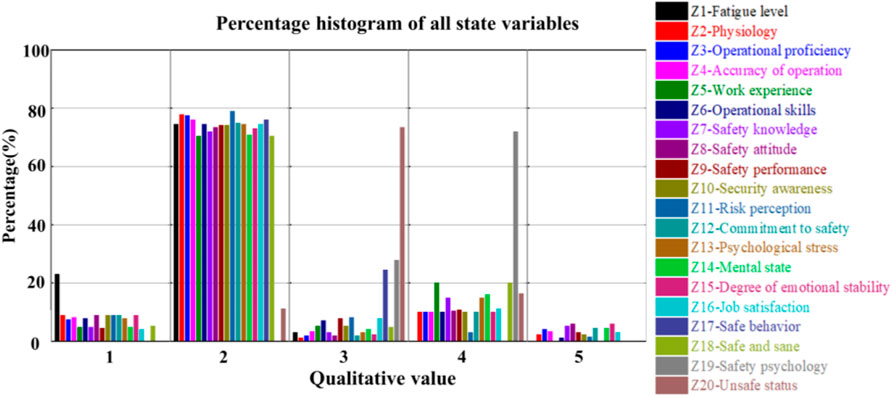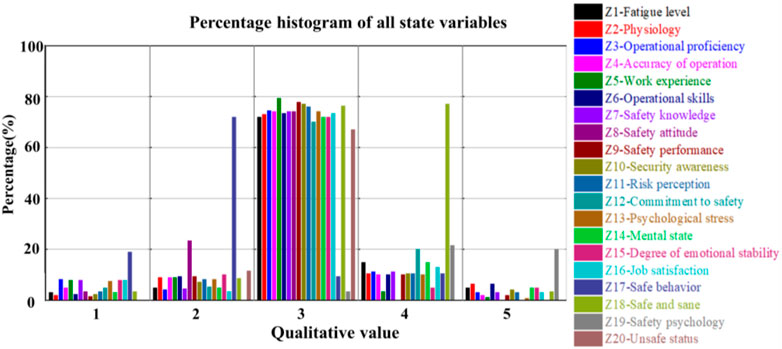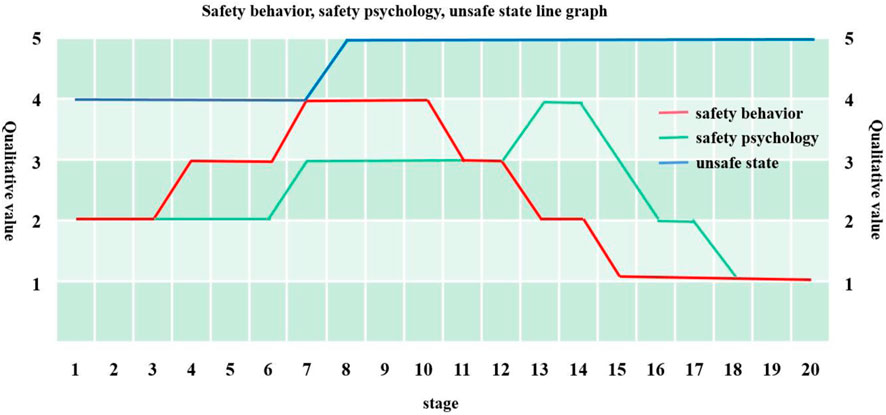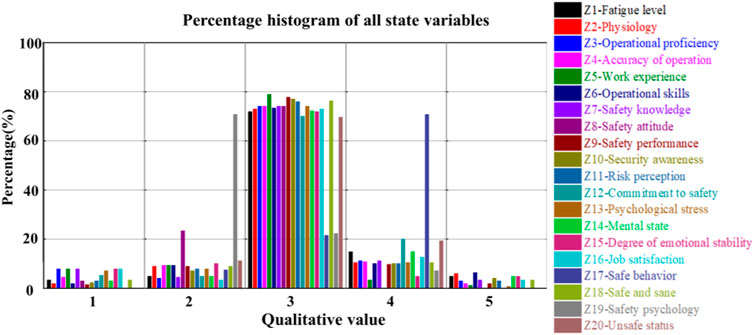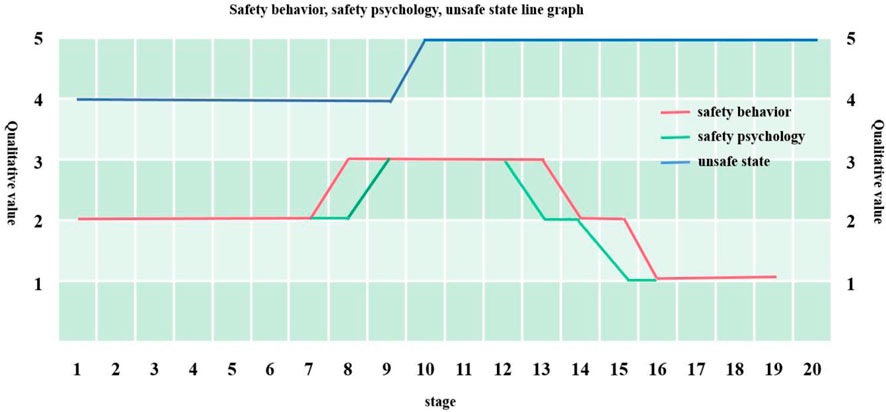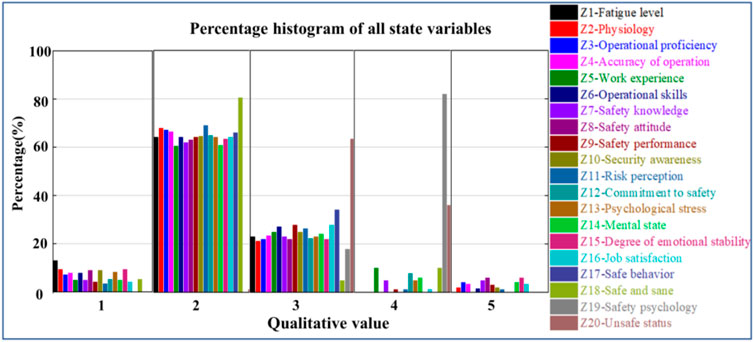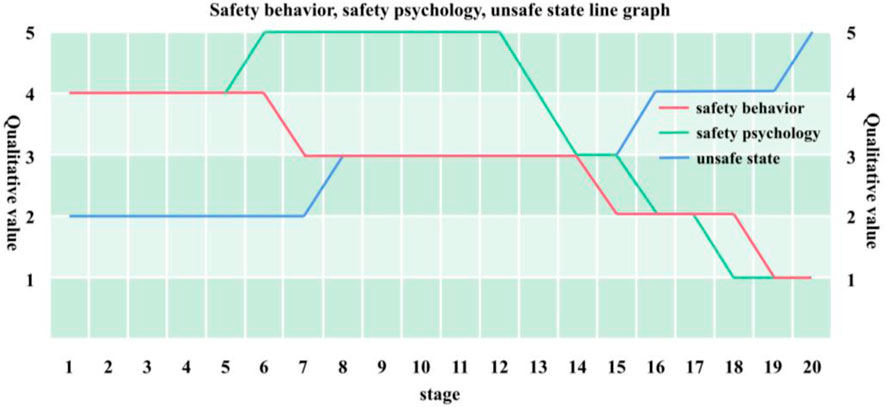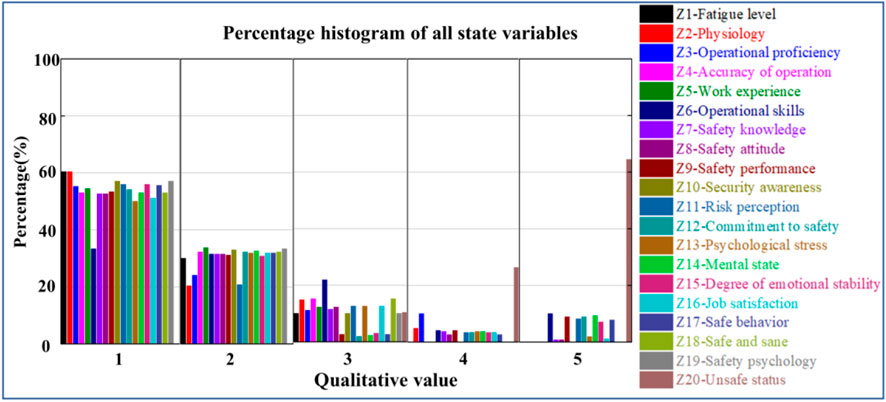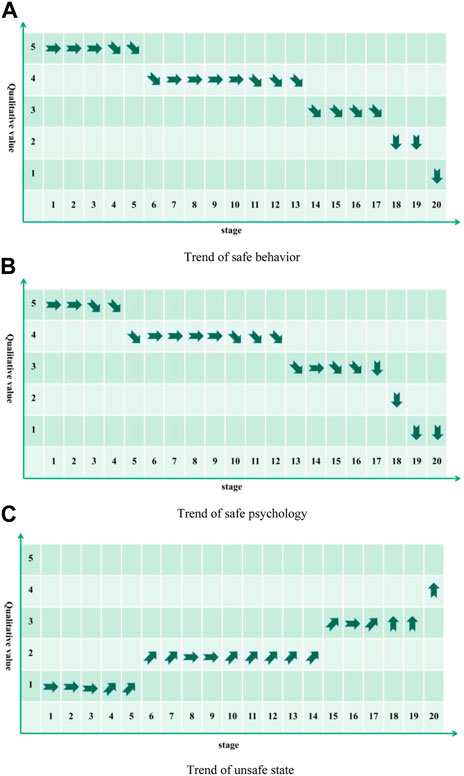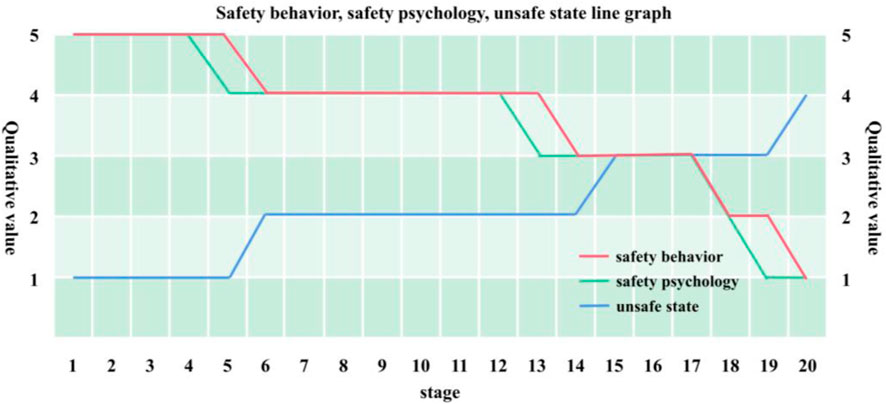- 1College of Finance and Economics, Shandong University of Science and Technology, Taian, China
- 2College of Economics and Management, Shandong University of Science and Technology, Qingdao, China
- 3College of Safety and Environmental Engineering, Shandong University of Science and Technology, Qingdao, China
- 4Qingdao No.1 Municipal Engineering Co., Ltd., Qingdao, China
The coal mine production safety hazards are large, and the situation is difficult, and coal mine workers are affected psychologically, producing unsafe psychological states and triggering unsafe behavior. This paper firstly studies the interactive influence process of the unsafe psychological state of coal mine workers and reveals the emergence process of unsafe psychology and behavior of coal mine workers. According to the characteristics of qualitative simulation of safety behavior, safety psychology and unsafe state of coal mine personnel, 23 simulation schemes are designed, and simulation analysis is carried out using QSIM simulation software platform. According to the simulation results of 23 schemes, the dynamic emergence process of safety behavior, safety psychology, and unsafe state of coal mine workers was sorted out from the aspects of different states and the intensity of different management measures, and the law of the effect of coal mine workers' safety psychology on safety behavior and safety state was obtained , revealing the interactive influence of coal mine workers' psychology on the unsafe state and the internal evolution mechanism of the emergent process. It is of great theoretical and practical significance for coal mine safety management to study the interaction of hazardous psychological states of coal mine workers and the dynamic generation mechanism of the emergence process of unsafe behaviors.
Highlights
(1) Analyze and get the influencing factors of unsafe state of coal mine personnel.
(2) Study and reveal the interactive emergence process of unsafe states of coal mine personnel.
(3) Realize the simulation analysis of the unsafe state of 23 kinds of coal mine personnel.
1 Introduction
The report “National Energy Development Strategy 2030–2050” proposes that by 2050, the annual production of coal energy in China will be controlled at 3 billion tons, which indicates that the proportion of coal in our energy consumption structure will not change significantly in the future period (Li et al., 2015; Peng et al., 2018). There are many hidden dangers and problems in coal mine production, and the situation is severe. Although China has successively issued relevant laws, regulations, and rules on coal mine safety production, increased the safety supervision of coal mine production, and achieved some phased safety production results, the safety problems of coal mine production in China have not been fundamentally solved (He and Song, 2012; Dong et al., 2021a; Yin et al., 2023). Because 95% of China’s coal mining is an underground operation, the natural occurrence conditions of coal seams are poor, the mechanization level of coal production is low, the equipment is backward, the safety management lags behind, the coal mine safety production faces the threat of coal and rock power disasters and coal spontaneous combustion disasters, the occurrence rate and the death toll of coal mine safety accidents are still large (Tong et al., 2019a; Tong et al., 2019b; Liu et al., 2020).
The transformation and development of the coal mining industry structure, the psychology of coal mine workers are affected by many factors, and the unsafe psychological state is complex and variable (Margolis, 2010; Considine et al., 2017). At present, China’s energy structure transformation needs to be more urgent, on the one hand, coal enterprises have to “remove production capacity” to realize the transformation of energy structure as soon as possible (Zhang et al., 2018; Dong et al., 2021a; Chi et al., 2021), on the other hand, due to the domestic and international situation and other influences, coal enterprises bear the responsibility of energy underwriting (Han et al., 2018; Zhou et al., 2020). Under the pressure of two aspects, the coal production and supply as well as demand are tense, which further exacerbates the tension of safe production in the coal industry, and the psychological state of coal mine workers will also change accordingly (Qing-gui et al., 2012; Yang et al., 2022a). The “psychological-behavioral research” of coal miners is an essential part of the international mining occupational health and safety research (Yu et al., 2022). Compared with the current research progress of occupational health and safety management in various industries (Zhu et al., 2022), there is still a big gap in coal-rich countries (the United States and Australia). The number of coal mine production safety accidents and deaths in the coal industry in developed countries are lower than that in China (Wang et al., 2013; Wang et al., 2016; Zhang et al., 2022).
Using simulation technology can easily and flexibly reproduce the scene of the accident, which can effectively save economic costs. Due to the rapid development of computer technology, the ability of scholars to establish simulation systems has gradually increased. To some extent, it provides technical and theoretical support for describing human behavior characteristics (Qiao et al., 2018; Cao et al., 2019; You et al., 2019; Chen et al., 2022). Based on the existing research results in psychology and physiology, the combination of the generation and action mechanism of human emotions, related scholars have constructed a human behavior model, creating a new direction of human behavior simulation research (Reynolds, 1987; Yang et al., 2022b). At the same time (Reynolds, 1987; Tu and Terzopoulos, 1994; Zhang et al., 2017), used the law of individuals imitating each other in group psychology simulates human behavior (Musse and Thalmann, 1997; Thalmann et al., 2000). Conducted a simulation study of human group behavior through the psychological law of group spiritual unity in group psychology. Used emergence theory, CGP modeling method and Netlogo simulation platform to simulate and analyze the influencing factors of unsafe behavior dynamically, The research results confirm that the necessary means to reduce the emergence degree of hazardous behavior is to control the attributes of the factors most closely related to employee behavior. Yu et al. (2019a) used the fishbone diagram to analyze the influencing factors of unsafe behavior from five aspects, and established a system dynamics model of unsafe behavior intervention, and proposed a joint intervention strategy for unsafe behavior. Structural equation models are hypothetical models that construct models and causal relationships based on theoretical literature or past empirical laws. By collecting variable data, a theoretical simulation framework is constructed to determine the reasoning and accuracy of these design relationships. Design formula models can calculate the relationships between hidden variable structures by observing variables. The QSIM algorithm is derived and simulated based on the unsafe psychological state model of coal mine workers according to preset rules, in order to fully reproduce the inference process of state evolution. This algorithm considers the unsafe psychological state of coal mine workers as a complex system. Starting from the initial situation of the system, rules are derived as constraints to reasonably deduce its continuous state changes, and the states of each stage are integrated in sequence to transform into visible state trends. Benjamin Kuipers of the University of Texas proposed a QSIM algorithm based on qualitative differential equations and constraints, gradually moving qualitative simulation from theory to application (Kuipers, 1986). Leitch R proposed that QSIM can use constraint equations to further screen newly generated states, filtering out most of the non compliant subsequent states (Leitch et al., 1991).
Chen et al. (2010) analyzed the causes of typical major accidents in coal mines from 2005 to 2010, established a causal model of human errors in mine accidents, and based on this, from research and development, management, law enforcement three perspectives put forward new ideas of safety management in line with China actual situation. Introduced HFACS (Human Factors Analysis Classification System) in the related research on miners’ unsafe behavior, established a multi-level influencing factor model and SD (System Dynamics) simulation model. It can be seen that the security state of the organization has the greatest impact on the unsafe behavior of miners. Used 3D simulation technology to simulate the accident consequences that may be caused by miners’ unsafe behavior, and established an unsafe behavior warning system to strengthen workers’ safety awareness.
Based on this, the unsafe behavior of coal mine workers depends on their physiological and psychological state. The unsafe psychological state of coal mine workers is a key link to producing unsafe behavior, when an unsafe physiological and psychological state occurs, the probability of causing unsafe behavior increases in the production process, which has a serious impact on the safety production of coal mine enterprises and working groups. Therefore, it is the primary purpose of this research to study the interactive influencing factors of the unsafe mental state of coal mine workers, based on the literature search and qualitative analysis of the unsafe psychological state of coal mine workers, the interactive factors analysis, model establishment, and calculation of the human factors, environment and behavior of the unsafe psychological state of coal mine workers are carried out, and the interaction factors affecting the unsafe psychological state of coal mine workers are studied. Secondly, according to the interaction factors involved in the dangerous psychological state of coal mine workers obtained from the previous research, simulation calculations are carried out to qualitatively describe the influence of the interaction factors that cause coal mine workers’ psychological state on the unsafe psychological state. Thirdly, through the experimental test of coal mine workers’ psychology on unsafe state, further statistical verification is carried out to analyze the development and evolution process of coal mine workers’ unsafe psychology.
2 The interactive influence of unsafe psychological state of coal mine workers
The first characteristic of coal mine workers’ work is the special working environment. Specifically, the working space is narrow, the working environment is dark, the environmental humidity is high, the scope of personnel activities is limited, and the workplace of workers is not fixed, etc. The second characteristic of the work of coal mine workers is that the working conditions are difficult. The main reasons include the remoteness of the work route and the long working time of each well. Long-term high-intensity work is easy to lead to fatigue and distraction. The third characteristic of the work of coal mine workers is that the underground production process is complex. The fourth characteristic of the work of coal mine workers is that the underground natural disasters are serious, and the coal mine working environment is poor, similar to gas, mine water penetration and other natural disasters that occur frequently.
The proposal of influencing factors mainly revolves around the actual production of miners underground. Through statistical analysis, literature review, on-site research, questionnaire survey, personnel interviews, and expert consultation methods, we deeply understand the psychological and behavioral reality of coal mine workers from various aspects such as their ideology, work, life, individual quality, and human biological rhythm. We analyze the causes and processes of unsafe psychology, and grasp the overall characteristics of coal mine workers, Analyze the specific manifestations of the unsafe psychological state of coal mine underground personnel, in order to determine the influencing factors of the unsafe psychological state of coal mine employees.
According to the working characteristics and psychological characteristics of coal mine workers, the identification indexes of unsafe psychological state of coal mine workers are determined, which mainly include: 1) Dangerous psychology: Paralytic psychology, shortcut psychology, fluke psychology, reverse psychology, adventure psychology; 2) Psychological characteristics: Personality, temperament, and emotions; 3) Personality tendency, including safety attitude, is the unique value judgment and psychological tendency of coal mine workers to work safety in the process of production and operation. Generally, safety attitude will affect the degree of coal mine workers’ compliance with safety rules and regulations, as well as safety motivation and safety needs. 4) Safety stress, including psychological stress regulation and emotional control ability. Statistical analysis of data, the psychological survey model of coal mine workers is obtained as shown in Figure 1.
As can be seen from Figure 1, according to the model, the influencing factors of employees’ mental health status are divided into two categories: job requirements and job resources. Excessive job requirements can lead to negative psychological states, and adequate work resources can alleviate the negative effects of job requirements on psychological states, thereby effectively promoting mental health. Employees with higher personal psychological resources can also play a similar job resource role. The psychological state of employees further affects their usual job satisfaction and loyalty to the organization. According to the model, if employees are expected to have a higher level of mental health, as well as higher satisfaction and loyalty to the organization, they can work more actively and create more excellent value for the organization.
The questionnaire survey in this article was first conducted on a small scale. 220 questionnaires were distributed and collected at Jining No. 2 Coal Mine of Yankuang Energy Group Co., Ltd. Based on feedback from respondents, the psychological survey scale for coal mine employees was modified to form an initial survey scale, which is divided into the measurement scale for basic information and psychological identification indicators of respondents. Due to the fact that the essence of the psychological safety questionnaire lies in the psychological measurement scale, which provides the corresponding degree of psychological feelings expressed by each question. The survey involved male participants. During the survey, a total of 615 questionnaires were distributed and 550 valid questionnaires were collected.
The survey mainly involves personnel from coal mining enterprises, departments, mining areas, and underground personnel. The types of work involved include coal mining, excavation, mechanical and electrical, transportation, ventilation, and safety supervision personnel. The working environment of different types of work varies, and the differences in the environment above and below the mine can cause different psychological pressures on coal mine workers. In addition, there are significant cultural differences between different types of work, and the level of education not only affects the unsafe psychological behavior of miners, but also increases the difficulty of on-site safety management in mines.
According to factor analysis, four dimensions of safety psychology, psychological characteristics, personality tendency and psychological pressure are determined to identify the unsafe psychological state of coal mine workers. The four dimensions of safety psychology, psychological characteristics, personality tendency and psychological stress are taken as the four latent variables of the model, and the corresponding indicators of each dimension are taken as the observed variables. Based on this, the original structural equation model of the identification index value of an unsafe psychological state of coal workers is generated. The construction and analysis of the structural equation model can be completed according to Amos software. AMOS is a powerful structural equation (SEM) modeling tool that extends traditional multivariate analysis methods including regression, factor analysis, correlation analysis, and variance analysis. In the AMOS environment, models can be specified, estimated, evaluated, and set under an intuitive path map to display the relationships between assumed variables, facilitating the establishment of behavioral attitude models that can truly reflect complex relationships. The original structural equation model is tested to verify the five basic assumptions proposed. After testing, the initial structural equation model is modified after deleting the wrong path. The modified structural equation model is shown in Figure 2.
Before conducting molecular analysis, it is necessary to first check whether factor indicators are suitable for factor analysis. Common test methods include KMO test and Bartlett spherical test. The result of the KMO test is between 0 and 1. The closer the KMO statistic is to 1, the higher the correlation between the factors is proven. It is generally believed that a value of KMO greater than 0.5 indicates that the indicator factor is suitable for factor analysis.
As shown in Figure 2, using SPSS software, confirmatory factor analysis was carried out on each variable, the deleted and merged indicators are divided into 4 principal components: safety psychology, personality tendency, psychological characteristics and psychological pressure. These 4 principal components explain 82.936% of the variance accumulatively, which can meet the statistical requirements. The reliability test shows that the Cronbach’s alpha coefficient of each dimension index is between 0.7 and 0.9, and the identification index has good reliability, which verifies the rationality of the index division. Personality tendencies have a significant positive impact on psychological stress; psychological characteristics have a significant positive impact on safety psychology; psychological characteristics have a significant positive impact on psychological stress.
3 Simulation research on the influence of coal mine personnel psychology on unsafe state
Based on the research on the influence and emergence mechanism of coal mine workers’ psychology on their unsafe state, the QSIM model to simulate the unsafe state of coal miners was constructed, and the mapping relationship and laws between psychology and unsafe state was explored (Yu et al., 2019b; Cao et al., 2019; Xu et al., 2023). QSIM directly uses the relevant parameters of the device as state variables to describe the physical structure, derives the constraint relationship between the parameters from physical and mathematical laws, and treats the change of the parameters over time as a qualitative state sequence. Starting from the initial state, first generate all possible subsequent states, and then eliminate the impossible states through qualitative constraints. Repeat this process until no new states are generated (Shen and Leitch, 1993; Engler and Soultanis, 2005). Among them, the elements of QSIM model come from the index system constructed above.
According to the influencing factors and index system of unsafe state studied above, combined with the characteristics of QSIM modeling, the QSIM model of the unsafe state of coal mine personnel is constructed from the aspects of physiology and psychology. The rectangular block diagram in the model represents the system state variables, that is, the important indicators of the unsafe state of coal miners that need to be studied, and is expressed in two tuples
Integrate and build QSIM model of unsafe state of coal mine personnel, as shown in Figure 3.
Based on the analysis of the relationship between the important influencing factors of the unsafe state of coal miners, the model describes the causal effect of each factor, including 20 system state variables, 13 management variables, 14 interference variables and 4 shadow variables. Based on this model, this paper will design a variety of simulation schemes, and explore the influence law of coal miners’ psychology on their unsafe state by analyzing the simulation results.
The initial states of the management variables, interference variables and system state variables of the QSIM model (Figure 3) of the unsafe state of coal mine personnel are different, and the initial conditions of the unsafe state represented are different. In order to facilitate the analysis of the evolution process of the hazardous state of coal miners in the face of interference and intervention measures, as well as the influence law of psychology on the unsafe state, the initial state of each factor in the hazardous state model of coal mine personnel was analyzed, and different initial values of model variables according to different situations was set. Combined with the unsafe state model of coal mine personnel, and comprehensively considering the various state combinations (management, interference and system state variables) that coal mine personnel may appear in safety production, 23 simulation schemes (Table 1) are finally designed, in which each scheme represents the initial state under a typical situation.
All schemes are to analyze the impact of psychological factors on the unsafe state of coal mine personnel. Among them, scheme 1 mainly analyzes the situation that no countermeasures are taken in the face of interference in the initial state of “general”; scheme 2 is to analyze the decision-making equivalent to the interference intensity under the same initial state; scheme 3 is to analyze the situation of taking high-intensity countermeasures in the face of interference under the same initial state; scheme 4–9 mainly analyzes the situation of strengthening or weakening physiological and psychological measures respectively in the initial state of “general”. Schemes 10 and 11 analyze the situation that when the initial state of each factor of coal mine personnel is “low” (qualitative value is 2), countermeasures with the same intensity and high intensity as the interference intensity are taken; schemes 12 and 13 analyze the situation of strengthening or weakening physiological and psychological measures respectively when the initial state is “low”. Scheme 14–16 analyzes the situation that when the initial state is “high”, no countermeasures are taken in the face of interference, countermeasures equivalent to the interference intensity and Countermeasures higher than the interference intensity are taken; scheme 17–22 analyzes the situation of strengthening or weakening physiological and psychological measures respectively when the initial state is “high”. Scheme 23 analyzes the situation that no countermeasures are taken in the face of interference when the initial state is “very high".
4 Qualitative simulation and result analysis
The simulation results of the initial state are shown in Figure 4, Z1–Z19 are concentrated at the “very low” (qualitative value is 1) level, while Z20 is concentrated at the “very high” (qualitative value is 5) level. This shows that in the face of external interference, without taking control measures, that is, when X=0, Y=1, Z=< 3, →>, all elements of coal mine personnel will eventually develop in the direction of “very low” (qualitative value is 1). Under the comprehensive action of various factors, the unsafe state level of coal mine personnel is “very high”.
The evolution trend of safe behavior (Z17), safe psychology (Z19) and unsafe state (Z20) is shown in Figures 5–7.
Figure 5 shows the changing trend of safety behavior (Z17), it can be seen intuitively that safety behavior changes to “declining” from the 4th stage under the condition of external interference without any intervention measures, indicating that safety behavior of coal mine personnel begins to decline at this time. In stage 6, the safety behavior (Z17) is “weakened” (“↘”) the trend decreases to “low” (qualitative value is 2); until the 14th stage, the safety behavior (Z17) continues to be “weakened” (“↘”) the trend of decreased to “very low” (qualitative value is 1), and in the 18th stage, the change direction changed to “strong reduction” (“↓”), indicating that the safety behavior of coal miners will continue to accelerate and deteriorate.
Figure 6 shows the trend of safety psychology (Z19), it can be seen intuitively that safety psychology changes to “declining” (“↘”) from the 3rd stage under the condition of external interference without intervention measures, it shows that their safety psychology begins to decline at this time. In the 15th stage, safety psychology (Z19) is “weakened” (“↘”) the trend of decreases to “low” (qualitative value is 2); until the 13th stage, the safety psychology (Z19) continues to be “weak” (“↘”) the trend of decreased to “very low” (qualitative value is 1), and in the 17th stage, the change direction changed to “strong reduction” (“↓”), indicating that the safety psychology of coal miners will continue to accelerate and deteriorate.
Figure 7 for unsafe condition (Z20) change trend, can visually see unsafe condition under the condition of the interference is not intervention, from the 4th state, change direction into a “weak plus” (“↗”), showed that coal mine personnel unsafe condition under the action of the psychological and behavior, began to rise. In the 6th stage, “weak plus” (“↗”). The trend rises to “high” (qualitative value is 4); until the 15th stage, continuing with “weak addition” (“↗”) the trend rose to “very high” (qualitative value is 5), and in the 18th stage, the change direction changed to “imposed” (“↑”), indicating that the unsafe state of coal miners is still high and will continue to accelerate the deterioration.
Through in-depth comparative analysis of the change trends of safe behavior (Z17), safe psychology (Z19) and unsafe state (Z20) (Figures 5–7), Figure 8, comparative analysis of the change trends of safe behavior (Z17), safe psychology (Z19) and unsafe state (Z20) can be obtained.
It is not difficult to see from Figure 8 that at the initial stage of change, safety behavior (Z17) lags behind Safety Psychology (Z19), in contrast at the middle and later stages of change, unsafe state (Z20) lags behind safety behavior (Z17). This shows that when subjected to external interference, psychology changes first, followed by changes in safe behavior, and finally form a comprehensive effect, that is, changes in an unsafe state. For the potential relationship between safe behavior (Z17), safe psychology (Z19) and unsafe state (Z20), this paper will verify and deeply analyze it in the subsequent simulation scheme.
The representative results of simulation analysis of scheme 2-scheme 3 are as follows: Scheme 2–the state of each element is general. In the face of interference, take control countermeasures equivalent to the interference intensity, that is, X=1, Y=1, Z=< 3, → >. The simulation results of scheme 2 are shown in Figure 9. Z1–Z20 are concentrated in the “general” (qualitative value is 3) level. Through simulation and result summary and analysis, the simulation results of scheme 3 are shown in Figure 10. Z1– Z19 are concentrated at the “very high” (qualitative value is 5) level, while Z20 is concentrated at the “very low” level. This shows that in the face of external interference, when high-intensity control measures are taken, all elements will develop in the “very high” direction, and the unsafe state will develop in the “very low” direction.
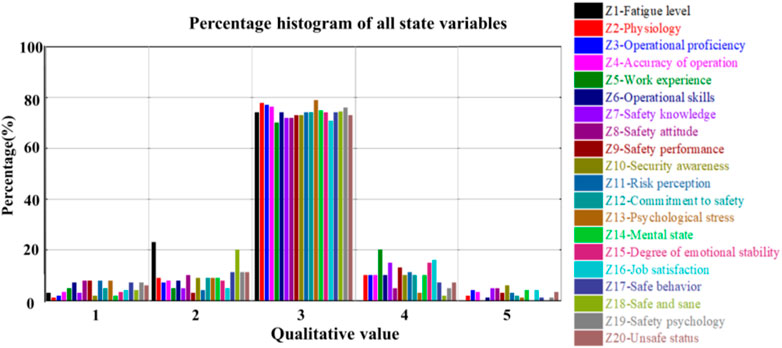
FIGURE 9. Simulation results of Scenario 2. Scheme 3—The state of each element is general. In the face of interference, take high-intensity control countermeasures, that is, X = 2, Y = 1, Z =< 3, → >. Through simulation and analysis, the simulation results of scheme 3 are shown in Figure 10. Z1–Z19 are concentrated at the “very high” (qualitative value is 5) level, while Z20 is concentrated at the “very low” level. This shows that in the face of external interference, when high-intensity control measures are taken, all elements will develop in the “very high” direction, and the unsafe state will develop in the “very low” direction.
The simulation results of scheme 4 are shown in Figure 11. Scheme 4 is to analyze the impact of psychological factors on the unsafe state of coal mine personnel by enhancing or weakening physiological and psychological measures in the face of interference when the initial state is “average”. The results show that Z1- Z18 are concentrated at the “low” (qualitative value of 2), while Z19 is at the “high” (qualitative value of 4), and Z20 is concentrated at the “general” level. This shows that in the face of external interference, when equivalent control measures are taken in terms of psychology, all elements will develop in the direction of “low”, safety psychology may develop in the direction of “high”, and unsafe state will develop in the direction of “general”.
In scenarios 12–13, the status of each element is at “low” level, and in the face of disturbances, different intensity of control measures are taken for psychological. The simulation results for scenario 12 are shown in Figure 12, where Z1–Z16, Z18, and Z20 are concentrated at the “fair” (qualitative value of 3) level, while Z17 is at the “low” (qualitative value of 2) level and Z19 is at the “high” (qualitative value of 4) level. This indicates that in the initial state of “low” level, in the face of external interference, in the physiological aspects to take equivalent control measures, the psychological aspects of high-intensity measures, and the elements will develop in the “general” direction, safety behavior may be to the “low” direction, safety psychological development to the “high” direction, the coal mine personnel unsafe state will develop to the “general” level.
The comparative analysis of the trends of safe behavior (Z17), safe psychology (Z19), and unsafe state (Z20) is shown in Figure 13.
From Figure 13, it can be obtained that in the process of unsafe state change of coal miners, safe behavior (Z17), safe psychology (Z19) and unsafe state (Z20) start to change at stage 3, stage 6 and stage 7, respectively, which shows that the latest response in this case is safe behavior (Z17), followed by safe psychology (Z19) and finally unsafe state (Z20).
The simulation results of scheme 13 are shown in Figure 14. Z1–Z16, Z18, Z20 are concentrated at the “general” (qualitative value of 3), while Z17 is at the “high” (qualitative value of 4) level, and Z19 is at the “low” (qualitative value of 2) level. This shows that when the initial state is “low”, in the face of external interference, when high-intensity control measures are taken in the physiological aspect and equivalent interference measures are taken in the psychological aspect, and the most elements will develop in the “general” direction, safety behavior may develop in the “high” direction, and safety psychology will develop in the “low” direction. Under the action of the two, the unsafe state of coal mine personnel will develop in the “general” level.
The comparative analysis of the trends of safe behavior (Z17), safe psychology (Z19), and unsafe state (Z20) is shown in Figure 15.
From Figure 15, it is easy to see that in the process of coal miners unsafe state change, safe behavior (Z17), safe psychology (Z19) and unsafe state (Z20) start to change at stage 7, stage 8 and stage 9 respectively, which shows that in this case, the latest response is safe behavior (Z17), and followed by safe psychology (Z19) and finally unsafe state (Z20).
The simulation results for scheme 17 are shown in Figure 16, analyzes the impact of psychological factors on the unsafe state of coal mine personnel. When the initial state is “high”, in the face of interference, physiological and psychological measures are strengthened or weakened. The results show that Z1–Z18 are concentrated in the “low” (qualitative value of 2) level, while Z19 is concentrated in the “high” (qualitative value of 4) level and Z20 is concentrated in the “average” (qualitative value of 3) level. This indicates that in the face of external disturbances, when psychological control measures are taken, the elements will develop in the direction of “low”, the security psychology may develop in the direction of “high”, and the insecurity will develop in the direction of “average”.
The comparative analysis of the trends of safe behavior (Z17), safe psychology (Z19), and unsafe state (Z20) is shown in figure.
It can be seen from Figure 17 that in the process of changing the unsafe state of coal miners, the first response is safety psychology (Z19), followed by safety behavior (Z17), and finally the unsafe state (Z20).
Scenario 23–the state of each element is at the “very high” level and no control measures are taken in the face of disturbances, i.e., X=0, Y=1, Z=<5, →>. The simulation results for scenario 23 are shown in Figure 18, where Z1-Z19 are concentrated at the “very low” (qualitative value of 1) level, while Z20 is concentrated at the “very high” (qualitative value of 5) level. This indicates that the system state is at a “very high” level, and when no control measures are taken in the face of external disturbances, i.e., X=0, Y=1, Z=<5, →>, all elements of the coal mine personnel will eventually develop in the direction of “very low” (qualitative value of 1). Under the combined effect of all elements, the level of unsafe condition of coal mine personnel is “very high".
Based on the above analysis, the entire process of the simulation with the highest degree of agreement with the initial state simulation results (the 1000th simulation of this program) was selected, and the evolution trends of safety behavior (Z17), safety psychology (Z19) and unsafe state (Z20) were analyzed, and their change trend graphs were made respectively, as shown in Figure 19.
Figure 19A shows the trend of safe behavior (Z17), Figure 19B shows the trend of safe psychology (Z19), and Figure 19C shows the trend of unsafe state (Z20). The trend of the change in safety behavior in Scenario 23 can be seen visually that the direction of change in safety behavior changes to “weakly diminishing” (“↘”) from stage 4 onwards when it is subject to external interference and no interventions are taken, indicating that the safety behavior of coal miners begins to show a downward trend at this time. In stage 6, the safety behavior (Z17) is “weakened” (“↘”), the trend of decreases to “high” (qualitative value is 4). Until the 14th stage, the safety behavior (Z17) continues to be “weakened” (“↘”). The trend of decreased to the “general” (qualitative value is 3), and in the 18th stage, the change direction changed to “strong reduction” (“↓”), and in the 20th stage, it fell to the “very low” level, indicating that the safety behavior of coal miners will continue to accelerate the deterioration.
Figure 20 shows that at the initial stage of change, safety behavior (Z17) lags behind Safety Psychology (Z19), while at the middle and later stages of change, unsafe state (Z20) lags behind Safety Psychology (Z19). This suggests that when subjected to external disturbances, psychological changes take the lead and affect changes in safety behavior, ultimately contributing to changes in the insecure state.
In summary, analyzing the simulation results of the 23 scenarios, the following laws regarding the unsafe psychology and state of coal mine personnel can be derived.
① When coal mine personnel in daily production, subject to variety of external interference, regardless of their initial safety state, no safety management, no targeted management measures, coal mine personnel’s safety behavior, safety psychology will develop to a “very low” level, unsafe state will develop to a “very high” level.
② When subjected to variety of external interference, if the intensity of the control measures taken and the intensity of interference is comparable or insufficient, the safety behavior of coal miners, such as the safety psychology will fluctuate, specifically in the form of first better and then back down to the original state, and finally to a lower direction; while the unsafe state is the opposite, first to a low direction and then up to the original state, and finally to a higher direction, when the intervention measures and the intensity of interference is comparable, the process contains a game.
③ If the intensity of the management measures taken is significantly higher than the intensity of the disturbance suffered, the safety behavior, safety psychology and unsafe state of the coal miners will improve significantly, but as the evolution progresses, the level of behavior, psychology and state will develop in a negative direction.
④ When the initial level of the system is different, without taking management measures or equivalent to the interference intensity, the higher the initial level of safety psychology, behavior and state, the slower its change to the negative direction.
⑤ In the face of external interference, enhance the psychological interventions, coal miners’ safety psychology will develop in the direction of “high” or “very high”, the trend and intensity of the unsafe state is basically the same as the safety psychology, but will lag behind the changes in safety psychology.
⑥ In the face of external disturbances and enhanced physiological interventions, the safety behavior of coal miners will develop in the direction of “high” or “very high”, and the intensity of change in the unsafe state will be slightly lower than that of unsafe behavior, but the trend of change is basically the same as that of safe behavior, and will lag behind the change in safe behavior.
⑦ In the face of external disturbances, only one aspect of the measures, regardless of the intensity, will eventually develop in a negative direction in terms of safety behavior, safety psychology and insecurity, and the rate of development will be higher than in the case of comprehensive interventions.
5 Conclusion
The influence relationship between the indicators of unsafe psychological state identification of coal mine workers was analyzed, and hypotheses were formulated and verified. Personality tendency had a significant positive effect on psychological stress; psychological characteristics had a significant positive effect on safety psychology; and psychological characteristics had a significant positive effect on psychological stress. According to the results of hypothesis verification, the structural equation model for coal mine workers’ unsafe state identification was constructed, and the fitted indicators were tested to be within a reasonable range.
The QSIM model of coal mine personnel unsafe state was constructed, and the model focused on the analysis of the relationship between the important influencing factors of coal mine personnel unsafe state, including 20 system state variables, 13 management variables, 14 interference variables and 4 shadow variables. Based on the simulation results of the 23 scenarios, the change process of coal mine personnel’s safety behavior, safety psychology and unsafe state were sorted out in terms of different states and the intensity of different management measures, and the law of the role of safety psychology on safety behavior and safety state was explored.
It is obtained that comprehensive high-intensity measures can keep the safety psychology and state of coal mine personnel at the “very high” or “high” level for a long time, but there will still be a downward trend in the end (“↘” Or “↓”), and may even fall to a “very low” level; when taking psychological management measures, the safety psychology and state of coal mine personnel will still rise, but it cannot reach the “very high” level; When the management measures are equivalent to the external interference, the change trend has fluctuations, which is the result of the game between various factors, which lays a research foundation for the study of the dynamic game evolution process of coal miners’ psychology on unsafe state.
To further improve coal mine safety production management, further research can be conducted from the following three aspects: The factors affecting the unsafe status of coal mine workers are easily affected by the surrounding environment, especially changes in the international situation and national policy guidance, which also have a disturbing impact on the unsafe status of coal mine workers. The next step can be to conduct empirical research based on this research, establish a group emergence model, and continuously revise and improve the emergence mechanism of unsafe states among coal mine employees. The experimental tests on the unsafe psychology and behavior of different coal mine groups can be conducted, and provide corresponding safety management measures.
Data availability statement
The original contributions presented in the study are included in the article/supplementary material, further inquiries can be directed to the corresponding authors.
Author contributions
All authors contributed to the study conception and design. Material preparation, data collection and analysis were performed by ZL, WM, BK, KY, XM, and XZ. The first draft of the manuscript was written by JY and all authors commented on previous versions of the manuscript. All authors contributed to the article and approved the submitted version.
Funding
This research was jointly supported by the Open Project Funding of the Qingdao West Coast New Area Industry and Information Technology Bureau Science and Technology Benefiting People Project (2021-109).
Conflict of interest
Author XZ was employed by Qingdao No.1 Municipal Engineering Co., Ltd.
The remaining authors declare that the research was conducted in the absence of any commercial or financial relationships that could be construed as a potential conflict of interest.
Publisher’s note
All claims expressed in this article are solely those of the authors and do not necessarily represent those of their affiliated organizations, or those of the publisher, the editors and the reviewers. Any product that may be evaluated in this article, or claim that may be made by its manufacturer, is not guaranteed or endorsed by the publisher.
References
Engler, A., and Soultanis, N. (2005). Droop control in LV-Grids[C]. Int. Conf. Future Power Syst. Amsterdam 11, 142–147. doi:10.1109/FPS.2005.204224
Cao, Q., Yu, K., Zhou, L., Wang, L., and Li, C. (2019). In-depth research on qualitative simulation of coal miners’ group safety behaviors. Saf. Sci. 113, 210–232. doi:10.1016/j.ssci.2018.11.012
Chen, J., Cao, Q., Liu, Y., Takahashi, H., and Tokonami, S. (2010). An investigation on radon and thoron response of alpha-track detectors used in the Winnipeg case-control study. J. Shandong Univ. Sci. Technol. 29, 83–86. doi:10.1093/rpd/ncp177
Chen, K., Zhang, Q., Tao, Y., Luo, K., and Chen, Q. (2022). The slope safety, heavy metal leaching, and pollutant diffusion prediction properties under the influence of unclassified cemented paste backfill in an open pit. Int. J. Environ. Res. Public Health 19 (19), 12772. doi:10.3390/ijerph191912772
Chi, J., Wang, B., Zhang, H., Kang, J., Lu, T., Huang, Y., et al. (2021). Regional coal power overcapacity assessment in China from 2020 to 2025. J. Clean. Prod. 303, 127020. doi:10.1016/j.jclepro.2021.127020
Considine, R., Tynan, R., James, C., Wiggers, J., Lewin, T., Inder, K., et al. (2017). The contribution of individual, social and work characteristics to employee mental health in a coal mining industry population. PLoS One 12, e0168445. doi:10.1371/journal.pone.0168445
Dong, C., Qi, Y., and Nemet, G. (2021a). A government approach to address coal overcapacity in China. J. Clean. Prod. 278, 123417. doi:10.1016/j.jclepro.2020.123417
Dong, S., Wang, H., Guo, X., and Zhou, Z. (2021b). Characteristics of water hazards in China’s coal mines: A review. Mine Water Environ. 40, 325–333. doi:10.1007/s10230-021-00770-6
Han, S., Chen, H., Long, R., and Cui, X. (2018). Peak coal in China: A literature review. Resour. Conservation Recycl. 129, 293–306. doi:10.1016/j.resconrec.2016.08.012
He, X., and Song, L. (2012). Status and future tasks of coal mining safety in China. Saf. Sci. 50, 894–898. doi:10.1016/j.ssci.2011.08.012
Kuipers, B. J. (1986). Qualitative simulation. Artifical Intell. 29, 289–338. doi:10.1016/0004-3702(86)90073-1
Leitch, R., Freitag, H., Struss, P., and Tornielle, G. (1991). Artist: A methodological approach to specifying model based diagnostic systems. Milan Applications Conference.
Li, B.-B., Liang, Q.-M., and Wang, J. C. (2015). A comparative study on prediction methods for China's medium- and long-term coal demand. Energy 93, 1671–1683. doi:10.1016/j.energy.2015.10.039
Liu, Q., Liu, J., Gao, J., Wang, J., and Han, J. (2020). An empirical study of early warning model on the number of coal mine accidents in China. Saf. Sci. 123, 104559. doi:10.1016/j.ssci.2019.104559
Ma, J., and Dai, H. (2017). A methodology to construct warning index system for coal mine safety based on collaborative management. Saf. Sci. 93, 86–95. doi:10.1016/j.ssci.2016.11.012
Margolis, K. A. (2010). Underground coal mining injury: A look at how age and experience relate to days lost from work following an injury. Saf. Sci. 48, 417–421. doi:10.1016/j.ssci.2009.12.015
Musse, S. R., and Thalmann, D. (1997). A model of human crowd behavior: Group inter-relationship and collision detection analysis. Eurographics, 39–51. doi:10.1007/978-3-7091-6874-5_3
Peng, B., Guo, D., Qiao, H., Yang, Q., Zhang, B., Hayat, T., et al. (2018). Bibliometric and visualized analysis of China's coal research 2000–2015. J. Clean. Prod. 197, 1177–1189. doi:10.1016/j.jclepro.2018.06.283
Qiao, W., Liu, Q., Li, X., Luo, X., and Wan, Y. (2018). Using data mining techniques to analyze the influencing factor of unsafe behaviors in Chinese underground coal mines. Resour. Policy 59, 210–216. doi:10.1016/j.resourpol.2018.07.003
Qing-gui, C., Kai, L., Ye-jiao, L., Qi-hua, S., and Jian, Z. (2012). Risk management and workers’ safety behavior control in coal mine. Saf. Sci. 50, 909–913. doi:10.1016/j.ssci.2011.08.005
Reynolds, C. W. (1987). Flocks, herds and schools: A distributed behavioral model. ACM SIGGRAPH Comput. Graph. 21, 25–34. doi:10.1145/37402.37406
Shen, Q., and Leitch, R. (1993). Fuzzy qualitative simulation. IEEE Trans. Syst. Man Cybern. 23 (4), 1038–1061. doi:10.1109/21.247887
Thalmann, D., Musse, S. R., and Kallmann, M. (2000). From individual human agents to crowds. informatik/informatique.
Tong, R., Yang, Y., Ma, X., Zhang, Y., Li, S., and Yang, H. (2019a). Risk assessment of miners’ unsafe behaviors: A case study of gas explosion accidents in coal mine, China. Int. J. Environ. Res. public health 16 (10), 1765. doi:10.3390/ijerph16101765
Tong, R., Zhang, Y., Yang, Y., Jia, Q., Ma, X., and Shao, G. (2019b). Evaluating targeted intervention on coal miners’ unsafe behavior. Int. J. Environ. Res. public health 16 (3), 422. doi:10.3390/ijerph16030422
Tu, X., and Terzopoulos, D. (1994). Artificial fishes: Physics, locomotion, perception, behavior. ACM SIGGRAPH Comput. Graph. 28.
Wang, J., Feng, L., and Tverberg, G. E. (2013). An analysis of China's coal supply and its impact on China's future economic growth. Energy Policy 57, 542–551. doi:10.1016/j.enpol.2013.02.034
Wang, Z., Zhu, Y., Zhu, Y., and Shi, Y. (2016). Energy structure change and carbon emission trends in China. Energy 115, 369–377. doi:10.1016/j.energy.2016.08.066
Xu, Q., Peng, S., Xu, J., Jiao, F., Cheng, L., Jia, L., et al. (2023). Study on time effect of acidified pulverized coal micro components and discussion on mathematical correlation of influencing factors. Fuel 342, 127842–127849. doi:10.1016/j.fuel.2023.127842
Yang, L., Wang, X., Zhu, J., and Qin, Z. (2022a). Influencing factors, formation mechanism, and pre-control methods of coal miners' unsafe behavior: A systematic literature review. Front. Public Health 10, 792015–792019. doi:10.3389/fpubh.2022.792015
Yang, L., Wang, X., Zhu, J., Sun, L., and Qin, Z. (2022b). Comprehensive evaluation of deep coal miners’ unsafe behavior based on HFACS-CM-SEM-SD. Int. J. Environ. Res. public health 19 (17), 10762–10829. doi:10.3390/ijerph191710762
Yin, S., Shi, L., Liu, Z., Lu, W., Pan, X., Zhuang, Z., et al. (2023). Study on the variation laws and fractal characteristics of acoustic emission during coal spontaneous combustion. Processes 11 (3), 1–18. doi:10.3390/pr11030786
You, M., Li, S., Li, D., and Xia, Q. (2019). Study on the influencing factors of miners' unsafe behavior propagation. Front. Psychol. 10, 2467. doi:10.3389/fpsyg.2019.02467
Yu, K., Cao, Q., Xie, C., Qu, N., and Zhou, L. (2019a). Analysis of intervention strategies for coal miners' unsafe behaviors based on analytic network process and system dynamics. Saf. Sci. 118, 145–157. doi:10.1016/j.ssci.2019.05.002
Yu, K., Wu, L., and Zhou, L. (2022). Research on the mixed education mode for the safety engineering major during the coronavirus (COVID-19) epidemic. Int. J. Environ. Res. Public Health 19 (4), 1967. doi:10.3390/ijerph19041967
Yu, K., Zhou, L., Cao, Q., and Li, Z. (2019b). Evolutionary game research on symmetry of workers' behavior in coal mine enterprises. Symmetry-Basel 11 (2), 156–212. doi:10.3390/sym11020156
Zhang, J., Li, X., and Pan, L. (2022). Policy effect on clean coal-fired power development in China. Energies 15, 897. doi:10.3390/en15030897
Zhang, Y.-P., Li, J.-Z., Wang, X. J., Feng, G.-R., Zhang, B.-S., Wang, T.-R., et al. (2017). Relationship research between subjective well-being and unsafe behavior of coal miners. EURASIA J. Math. Sci. Technol. Educ. 13. doi:10.12973/ejmste/79046
Zhang, Y., Nie, R., Shi, R., and Zhang, M. (2018). Measuring the capacity utilization of the coal sector and its decoupling with economic growth in China’s supply-side reform. Resour. Conservation Recycl. 129, 314–325. doi:10.1016/j.resconrec.2016.09.022
Zhou, A., Hu, J., and Wang, K. (2020). Carbon emission assessment and control measures for coal mining in China. Environ. Earth Sci. 79, 461. doi:10.1007/s12665-020-09189-8
Zhu, J., Wang, X., Yang, L., Qin, Z., Geng, J., and Zhang, X. (2022). Research on the construction of a comprehensive evaluation model of psychological factors in coal mine workers' safety: Investigation and analysis of 1,500 miners in east China. Front. Public Health 10, 849733. doi:10.3389/fpubh.2022.849733
Keywords: coal mine workers’, unsafe state, simulation calculation, experiment, safety behavior
Citation: Yin J, Liu Z, Yu K, Kong B, Mou X, Zhang X and Ma W (2023) A study on the simulation of psychological and behavioral dynamics in the unsafe state of coal mine workers. Front. Earth Sci. 11:1085200. doi: 10.3389/feart.2023.1085200
Received: 31 October 2022; Accepted: 03 July 2023;
Published: 14 July 2023.
Edited by:
Miao Li, Charles Sturt University, AustraliaReviewed by:
Yang Xiao, Xi’an University of Science and Technology, ChinaYinan Guo, China University of Mining and Technology, China
Copyright © 2023 Yin, Liu, Yu, Kong, Mou, Zhang and Ma. This is an open-access article distributed under the terms of the Creative Commons Attribution License (CC BY). The use, distribution or reproduction in other forums is permitted, provided the original author(s) and the copyright owner(s) are credited and that the original publication in this journal is cited, in accordance with accepted academic practice. No use, distribution or reproduction is permitted which does not comply with these terms.
*Correspondence: Zhen Liu, MTc4NjU4MTE2NzJAMTYzLmNvbQ==; Biao Kong, a29uZ2JpYW84ODA3QDE2My5jb20=
 Jueli Yin1,2
Jueli Yin1,2 Biao Kong
Biao Kong